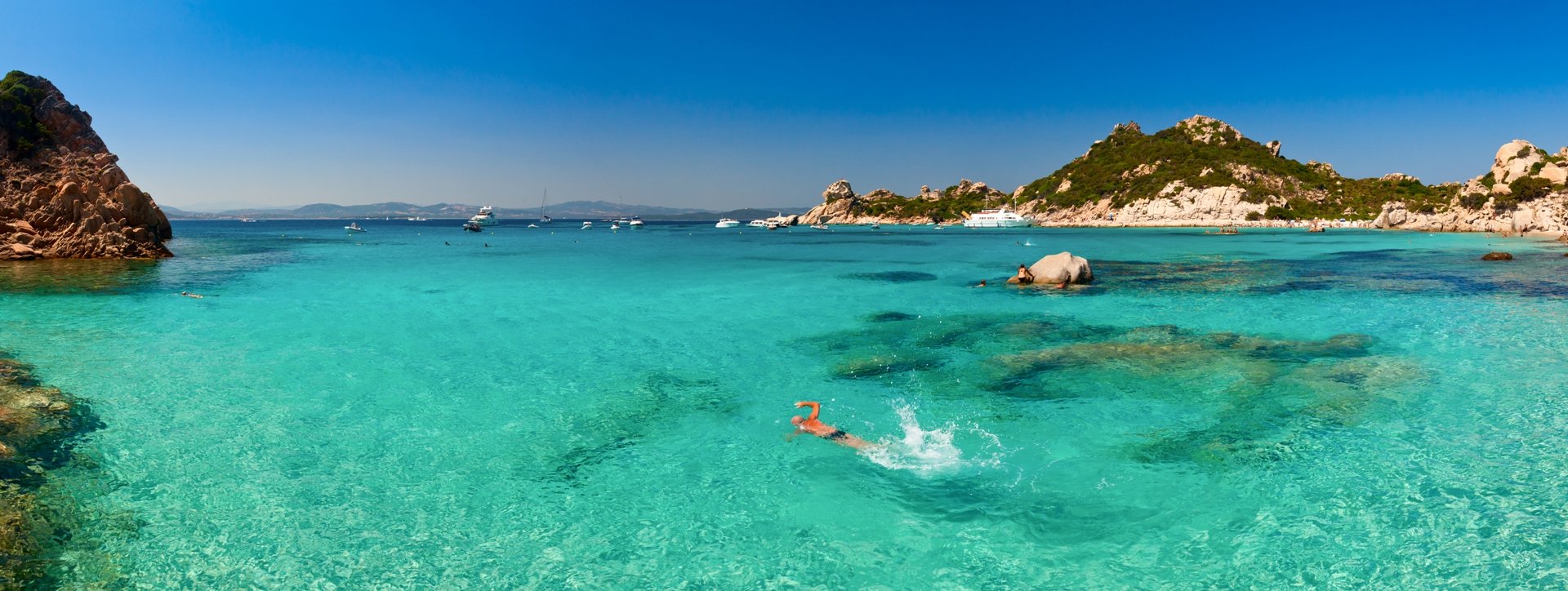What's the weather like?
Sardinia has a very pleasant Mediterranean climate with lots of sun, hot summers and mild winters. In short, a radiant destination!
The Italian island Sardinia is the second largest island in the Mediterranean sea, with an area of 24.090 square metres. The island measures 270 km from north to south and approximately 150 km from east to west. Surprisingly, Sardinia is located closer to Tunisia (180 km) than to the Italian mainland (190 km). Directly north of Sardinia is…
the Strait of Bonifacio, which separates Sardinia from the neighbouring French island of Corsica.
Sardinia has a very pleasant weather all year round. The subtropical Mediterranean climate is characterised by dry and often long warm summers and mild, moist winters. It only snows in the highlands in central Sardinia in winter. From December to February the winter is mild, but with high humidity levels. Spring starts in March and April. During the months of May and June the days are pleasant and the nights crisp. In summer, i.e. June through September, the temperatures rise to 30 - 35 degrees Celsius. The late summer, in October and November, is still very pleasant, allowing you to enjoy the mild days before winter takes over again.

Back in time
Through the centuries Sardinia has been occupied by many different people. The nuraghe and Domus de Janas which dot the island are the oldest traces of prehistoric human settlement in Sardinia.
Sardinia has been populated in various waves of emigration from prehistory until recent times. Prehistoric tribes have left impressive monuments, such as the Neolithic “Domus de Janas” and megalithic “nuraghes”, tower-fortresses made of many layers of stones. As time passed the Phoenicians and Carthaginians (550 BC) conquered Sardinia, followed by the Romans, the Vandals, the Byzantines and, in the 11th century, the Saracens.
Early 8th century BC the Phoenicians founded several cities…
in Sardinia; Tharros, Bithia, Sulci, Nora and Karalis (Cagliari). The Phoenicians, a civilization situated on the coastline of what is now Lebanon, traded in the Mediterranean, founding ports in the entire area. Sardinia was an ideal destination because of its strategic position towards Carthage (near the current Tunis); Spain; the Rhone delta and the Etruscan area (in parts of north Italy). The cities were situated strategically, often on peninsulas or on the coast. At that time Sardinia was the centre of several commercial routes and it was an important provider of raw materials, such as zinc and lead, extracted in the mining area near Iglesias.
After the Phoenicians the Carthaginians, also known as the Punics, originating of the former Phoenician colony Carthage, conquered the island, establishing control over a large part of Sardinia. In 238 the Romans seized power in Sardinia, gaining a fairly well-developed urban culture and infrastructure. Before conquering Egypt, the Romans used Sardinia together with Sicily as a granary for the city of Rome. However, even under Roman rule, the Punic culture remained visible. Nowadays Tharros, Nora, Bithia, Antas and Monte Sirai are important archaeological sites, while Karalis became the current capital of Sardinia; Cagliari.
After the Fall of the Western Roman Empire, after the Migration Period, Sardinia was subjected to various foreign rules. The German Vandals conquered Sardinia in 456 from north Africa, to be defeated by the Byzantines 80 years later. The Saracens regularly attempted to conquer the island from 711 onwards, causing the abandonment of the city of Tharros after more than 1800 years of inhabitation as well as the founding of the current Oristano.
During the battle for control of Sardinia the Maritime republics of Pisa and Genoa were called upon. From 1063 onwards a new political system was formed, dividing the Sardinian territory in 4 “giudicati” (judicati).
Eleanor of Arborea, one of the prominent figures in Sardinia during the Middle Ages, established a legal code, in force until 1827; the Carta de Logu, a work of great important in Sardinian history encompassing the civil and penal law.
During this period the influence of the Spanish increased until the Aragonese invaded Sardinia, to which time the Aragonese towers along the coast, protecting the island from the Arabs, date back. These towers, still visible today and situated in strategic places near the old Phoenician cities, were often built with stones reused from old constructions. The Santa Giusta Church in Oristano, where remains of the Phoenician city Othoca were found, is a beautiful example of this reutilisation.
From 1718 through 1861 (the Unification of Italy), Sardinia together with Piedmont formed the Kingdom of Sardinia. The development of the infrastructure progressed slowly. Under the rule of Charles Felix Sardinia’s main thoroughfare, which connects the towns of Cagliari and Sassari-Porto Torres, was installed. This road, the Strada statale 131 Carlo Felice, is named for him.
Mussolini drained the marshes near Oristano, laying the foundation of one the most successful agricultural communities in Sardinia; Arborea. Mussolini also founded Carbonia, named after the coal mines (“carbone”) in the area. After WOII, the importance of the coals declined, making way for tourism.

Varied landscape
High mountains, vast forests, white sandy beaches with crystal clear waters, undulating hills and stunning vistas. Sardinia, a natural beauty!
Sardinia has a diverse landscape; beautiful coastlines with numerous white sandy beaches, bays and clear blue waters contrast with the inland’s rugged landscape. Flat coasts merge into undulating hills and into lush mountains in central Sardinia. The highest mountains, the Punta la Marmora (1834 m.) and the Bruncu Spina (1829 m.) are a part of the Gennargentu. This mountain area in central-southern Sardinia encompasses the Gerrei mountain range in the south and the mountain Monte di Alba in the north. The Iglesiente and the Capoterra mountains border the southwestern part of the Gennargentu.
Sardinia has more than 1800 kilometres of coastline, which consist of…
small bays with beaches made of sand, shingle and pebbles. The rivers Conghinas, Mannu and Flumendosa are often dry because of Sardinia’s high temperatures and low levels of rainfall. The Tirso river is the most important, flowing into the artificial lake serving as a water supply for the entire island. The Temo river near Bosa is the only navigable river in Sardinia. There are several salt lakes in Sardinia, for example near Cagliari and Cabras, where many migratory birds, such as flamingos, reside all year round. Contrary to the ones in Cagliari and Cabras, the salt lagoon near Macchiareddu is still used for the harvesting of salt.

Traditional Sardinia
The Sardinians love their language, traditions and customs. Colourful and of original forms, the clothes worn by Sardinians during local festivities are a clear symbol of their love for their culture.
Sardinia has a very low population density. Most of the 1.644.000 inhabitants live in (the vicinity of) the cities.
Italian has been the official language on the island since the beginning of the 18th century. However, the island has its own language as well; Sardinian. Furthermore, each region has its own dialect. Sardinian, a distinct branch of the Romance language family, is still spoken by a large part of the population. Especially in the more secluded mountain villages...
Sardinian is still widely spoken. An exception to this rule is the area near Alghero, where a variant of the Catalan language is spoken; Algherese. A variant of Ligurian is spoken on the south-western island Carloforte. Most foreign languages spoken in the touristic areas are English and French.
Colourful and of various forms, the Sardinian traditional clothes have a Spanish and Moor origin. The clothes resemble not only the geographic background, but also the marital status and role of each member in the social area. There are more than 400 differentiating costumes in Sardinia. In several secluded villages there are some who still wear the traditional clothing. The traditional costumes and ornaments are important elements during Sardinian festivities, together with traditional music and dancing and – very important! – the local delicacies. A Sardinian folkloristic event is definitely worth a visit!

Pure Sardinia
Due to the fact that many Sardinians are employed in agriculture, farming and/or fishing or grow their food on their own piece of land, you can enjoy the pure Sardinian products.
Sardinia has been one of Italy’s autonomous regions since 8 March 1949. The island is divided into 8 provinces; Cagliari, Sassari, Nuoro, Oristano, Olbia-Tempio, Ogliastra, Medio Campidano and Sulcis-Iglesiente.
Sardinia’s economy depends primarily on the industry and agriculture. The Sardinians grow wheat, grapes, citrus fruits, olives and almonds. There are approximately 2,5 million sheep and 2 million cows, which accounts for 25% of…
Italy’s total livestock. Ca. 15% of the Sardinian workforce is employed in the agricultural secor.
In the coastal areas near Alghero, Cagliari, Cabras, Carloforte, Sant’Antioco and Tortoli the Sardinians fish for tuna, lobster and sea bass, which is an important source of income. The south-western island Carloforte, famous for its tuna, is often called the “tuna island”. Sardinian tuna is exported worldwide, but primarily to Japan.
Sulcis-Iglesiente is known for its once prosperous mining industry (manganese, marble, iron, copper, lead, zinc, silver) and Sarroch for the oil refineries. Ca. 30% of the workforce is employed here. Furthermore, the production of textiles, cork and food and the processing of lead and zinc are important sources of income.
The majority of the Sardinians is active in the tertiary sector (for example in commerce and government). Tourism has become the main industry of the island.

Pane, pasta and dolci
In Sardinia good food, preferably cooked with local ingredients, is of the utmost importance. Sardinians love to sit down and enjoy the tasty dishes of La Mamma together with friends or family.
The Sardinian cuisine is a fairly simple Mediterranean one, which focuses on the use of local ingredients such as bread, milk, cheese, meat and fish. Sardinians start their day with a simple breakfast which consists of coffee or milk with a sweet bun. At ca. 13.00h they sit down for an extensive “pranzo” (lunch). Dinner (“la cena”) is relatively light, since they often skip the pasta dish. Like all Italians Sardinians too love sharing their meals with friends and family.
The famous Pane carasau is Sardinia’s famous traditional flatbread. Since the production of this bread is fairly laborious, the Sardinians prefer leaving it to the bakers. Pane carasau can…
be eaten either dry or with a bit of olive oil and salt. By soaking the bread in water its elasticity returns, after which it can be used to make a lasagne like dish. However, the most popular preparation is “pane fratau”, which means covering the paper-thin bread with tomato pasta and poached or boiled eggs and grated cheese.
Other less crisp types of Sardinian bread are “il coccoi” and “il civraxiu”.
Sardinians excel at making cheese. Both at lunch and dinner they often serve at least one type of cheese. The most famous one is undoubtedly the “pecorino”, which owes its name to the local sheep (“pecore”) whose milk is used in the production. Its flavour varies from soft to salty and rich. Fresh pecorino and the slightly sweet ricotta are popular components of various traditional cookies as well.
Other than the classic Italian pasta dishes, Sardinians love to prepare their own traditional pasta called “malloreddus”, made from durum wheat flour, water and salt. The dough is rolled to create a small, shell-like pasta dumplings, which are very tasty when combined with a basic tomato sauce with “salsiccia” (sausage) and grated pecorino.
Many Sardinian dishes derive from old traditions. Back in the day, when shepherds setting out with their herds remained in the mountains for months, far away from their families and well-equipped kitchens, they had to make due with basic means. Not being able to bring pots and pans with them, they roasted their meat on wood carved skewers. Herbs were found along the way and basic yet tasty meals were cooked using pork, veal, goat or lamb. The contemporary Sardinian menus still incorporate grilled or roasted meat dishes and suckling pig roasted on the spit is still the highlight of every village festival.
Because of Sardinia’s position in the heart of the Mediterranean sea, fresh seafood dishes are an important part of the local cuisine. We definitely recommend trying the lobster “alla catalana”, cooked on a bed of fresh tomatoes, onion and olive oil, served near Alghero as well as the Sardinian specialty “bottarga”; pressed and salted mullet roe, served in slices on bread or grated over pastas together with olive oil and garlic.
Even though each region has its own local sweets, the traditional “sebadas” is served island-wide. This delicacy consists of cheese pressed into a circular pastry which after being fried in plenty of olive oil is covered with either bitter or sweet honey. Don’t forget to try the typically Sardinian biscuits when drinking a coffee. Buon appetito!





















